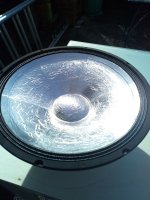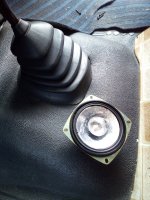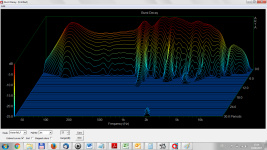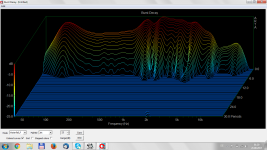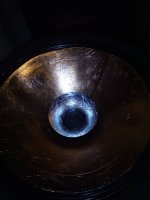@Lojzek , I was considering a HiVi too but I couldn't find one that was 6 ohms.
HiVi Q1R is a 6 ohm nominal unit, 90-91 dB. Does its flange measure right, I don't know.
HiVi K1 is so called 5 ohm unit, 91-92dB.
I don't see a problem.
If you do not want to measure your box, which could improve the whole speaker, but needs some learning (REW, Arta), the best way is to use a second, decend speaker as a reference. Play some well known music and connect the reference and the new speaker to one channel of your amp. Depending on your amp, there are serveral ways to make a smart connection, so you can switch from A to B without delay. If your amp has a mono switch and two speaker pairs, activate mono, connect one speaker to left and the first pair, the other to right and second pair. Now you can match levels with the balance pot and change speakers by switching from pair one to pair two. If you do not have a mono switch, just short right and left at the (CD) input.
This way, using some resistors and maybe another capacitor, you should be able to match the new tweeter. Without a reference you probably will tune it much too sharp, as a higher tweeter level sounds fresh in the beginning, but will fatique in the long run.
This way, using some resistors and maybe another capacitor, you should be able to match the new tweeter. Without a reference you probably will tune it much too sharp, as a higher tweeter level sounds fresh in the beginning, but will fatique in the long run.
No, you'll increase the chances of needing to change the crossover. Not that it wasn't likely in any case. Ensure enough sensitivity in the new tweeter. You wanted a challenge and I think this is going to be a good experience. 🙂is there a chance of burning the tweeter if i drop in a 4 ohm one instead of the 6 ohm or 8 ohm
If you order, you may buy a new electrolitic cap /these dry out) for the bass and, maybe, something better than the Bennic cap. Some say there are no worse film capacitors around than the yellow "B". May add 20$ to your final bill. If DigiKey is your source I may have a look for the right parts.
You seem to be fixed on getting a 6 Ohm tweeter. To tell the truth, this will not help you at all. You may even get allong better with a 4 or 8 Ohm speaker.
"Ohm" is a very useless classification for speaker sound, sound pressure level and reactance to an existing x-over. Sorry to say this, you are on a wrong path here. The original OEM speaker will be made to exactly match the two woofer configuration and make an additional (expensive) resistor obsolete. It will have low quality magnet material an maybe 88dB/1W/m
Anyone with some experience would measure the woofer or just make an educated guess. In allmost any case a tweeter you buy will be a little louder than needed. This is a good thing, as you can use one (or better, two) resistors to cool it down and match to your taste.
My pick would be the Peerless BC25TG15-04 at 22$ if I look at DigiKey. Then spent a few $ on some cheap 5W resistors to match the level. A very good chassis for a very reasonable price. You can find it in commercial speakers up to 1,000$ a pair. Not easy to get anything better up to maybe 50$. Other brands, other trade profit's.
It will sure improve your cheap Yamaha speaker if you match the level. This Peerless/ Vifa/ Tymphany chassis can be seen as the entry level to high end audio.
By the way, a 6.8uF capacitor is a common "fit's all" value for such 2-way builds. Maybe 6.1 or 7.5 would be better, but you will not hear the difference. So I would stay with that value. To your concerns about the Ohm thing, if you put a 2 Ohm resistor in front of the tweeter, you are back to 6 and the tweeter may get a very little bit less agressive. See how realtive this is?
You seem to be fixed on getting a 6 Ohm tweeter. To tell the truth, this will not help you at all. You may even get allong better with a 4 or 8 Ohm speaker.
"Ohm" is a very useless classification for speaker sound, sound pressure level and reactance to an existing x-over. Sorry to say this, you are on a wrong path here. The original OEM speaker will be made to exactly match the two woofer configuration and make an additional (expensive) resistor obsolete. It will have low quality magnet material an maybe 88dB/1W/m
Anyone with some experience would measure the woofer or just make an educated guess. In allmost any case a tweeter you buy will be a little louder than needed. This is a good thing, as you can use one (or better, two) resistors to cool it down and match to your taste.
My pick would be the Peerless BC25TG15-04 at 22$ if I look at DigiKey. Then spent a few $ on some cheap 5W resistors to match the level. A very good chassis for a very reasonable price. You can find it in commercial speakers up to 1,000$ a pair. Not easy to get anything better up to maybe 50$. Other brands, other trade profit's.
It will sure improve your cheap Yamaha speaker if you match the level. This Peerless/ Vifa/ Tymphany chassis can be seen as the entry level to high end audio.
By the way, a 6.8uF capacitor is a common "fit's all" value for such 2-way builds. Maybe 6.1 or 7.5 would be better, but you will not hear the difference. So I would stay with that value. To your concerns about the Ohm thing, if you put a 2 Ohm resistor in front of the tweeter, you are back to 6 and the tweeter may get a very little bit less agressive. See how realtive this is?
I bought a pair of smaller ones of the same range.
Used the box for my own drivers so I had a cheap but nice looking enclosures for my own project.
With one pair I made following tweaks:
Putting 1cm concrete on every side - inside the box - one day for every side let it dry. Front panel got some thicker wood pieces glued inside.
If you use original drivers. Put aluminium foil for the bass driver on one or both sides of the diaphragm, ventilate it where the dust cap is and the yellow spider.
Tweeter gets smaller mkp cap
Damping the box from inside with 5cm foam on all internal sides.
Make the reflex port longer - how much the depth of the box is to tune it lower.
Then just use eq from the smartfone with eq app to make it linear
This box is like fullrange driver with added tweeter and should sound pretty well after doing all this.
Or even linearize also phase response with rephase
Used the box for my own drivers so I had a cheap but nice looking enclosures for my own project.
With one pair I made following tweaks:
Putting 1cm concrete on every side - inside the box - one day for every side let it dry. Front panel got some thicker wood pieces glued inside.
If you use original drivers. Put aluminium foil for the bass driver on one or both sides of the diaphragm, ventilate it where the dust cap is and the yellow spider.
Tweeter gets smaller mkp cap
Damping the box from inside with 5cm foam on all internal sides.
Make the reflex port longer - how much the depth of the box is to tune it lower.
Then just use eq from the smartfone with eq app to make it linear
This box is like fullrange driver with added tweeter and should sound pretty well after doing all this.
Or even linearize also phase response with rephase
I Guess that if you put aluminum foil you add Mass > the woofer go slower. So It would Need to be low-passed lower and the tweeter needs more 'presence', so the advice to reduce the value of the cap before the tweeter (..and what about the coil?!) seems unlogic
Now I see...even linearize also phase response with rephase
By the way, what Yamaha speaker Is the smaller One? It has Double or single speaker ? I bet it's different...I've never listened to double woofers cabinet, at least... usually they are single and displaced One for each Channel...
I,Ve never listened to floorstanding speakers either... listening to floorstanding speakers having two woofers each must be an experience!
I,Ve never listened to floorstanding speakers either... listening to floorstanding speakers having two woofers each must be an experience!
With EQ you can adjust your speaker to good sound.
The aluminium foil is only making the driver sound better. The little bit weight does not make a harm nor does it take so much away from the driver on the upper end that there will be a suckout. However you can correct this with the EQ.
The tweeter usually has an electrolytic which is too big. If you change to MKP try 2.2 mfd or 3.3. mfd. But not more because for 6db filter 4.7 or more is too big.
You can measure with your smartfone with apps like spectroid and some white noise or pink noise - these sound files you can get from youtube.
The aluminium foil is only making the driver sound better. The little bit weight does not make a harm nor does it take so much away from the driver on the upper end that there will be a suckout. However you can correct this with the EQ.
The tweeter usually has an electrolytic which is too big. If you change to MKP try 2.2 mfd or 3.3. mfd. But not more because for 6db filter 4.7 or more is too big.
You can measure with your smartfone with apps like spectroid and some white noise or pink noise - these sound files you can get from youtube.
Half of the good sound is the enclosure.
If you have a good enclosure and good damping and a low tuned reflex. You can leave the aluminium tweak out. Just EQ to taste the box.
You can really hear the ventilation for the bass drivers. Makes a big difference. The dustcap should get a small hole and the yellow spider, too.
If you would ask me what is the most audible fault in a loudspeaker like this it would be the completely missing damping inside the box.
If you have a good enclosure and good damping and a low tuned reflex. You can leave the aluminium tweak out. Just EQ to taste the box.
You can really hear the ventilation for the bass drivers. Makes a big difference. The dustcap should get a small hole and the yellow spider, too.
If you would ask me what is the most audible fault in a loudspeaker like this it would be the completely missing damping inside the box.
Aluminium foil tweak looks like this for loudspeakers just cut normal aluminium foil for the household into pieces like parts of a cake and glue them with some household glue onto the diaphragm.
To bring distortion down with a loudspeaker like this build you own cheapo current drive amplifier. This lowers distortion by 10-20db(!)
https://www.diyaudio.com/community/threads/chip-amp-modification-to-current-drive.389985/
Its a thread I started on this topic.
To bring distortion down with a loudspeaker like this build you own cheapo current drive amplifier. This lowers distortion by 10-20db(!)
https://www.diyaudio.com/community/threads/chip-amp-modification-to-current-drive.389985/
Its a thread I started on this topic.
Attachments
This is a Saba Greencone with aluminium tweak (but very thin foil)
The measurement is immediately after putting the foil onto the driver as I usually do not like to wait to make the measurements.
The frequency response on the upper side of the audio spectrum after some days returns again after the glue has evaporated. It evaporates slowly because the aluminium does not allow for fast evaporation.
One image without aluminium, one image one sided aluminium third image both sides aluminium (sandwich cone)
you usally get a resonance free fullrange loudspeaker or at least minimized resonances but a much stiffer cone which sounds quite high-endish
The measurement is immediately after putting the foil onto the driver as I usually do not like to wait to make the measurements.
The frequency response on the upper side of the audio spectrum after some days returns again after the glue has evaporated. It evaporates slowly because the aluminium does not allow for fast evaporation.
One image without aluminium, one image one sided aluminium third image both sides aluminium (sandwich cone)
you usally get a resonance free fullrange loudspeaker or at least minimized resonances but a much stiffer cone which sounds quite high-endish
Attachments
There are a lot of mods for loudspeaker diaphragms.
But really adding stiffness to the cone by putting a metal foil on it has a dominant influence on stability. Much more than any plastics or varnish or hair spray.
Here you can read about hifi history. You should understand that the use of polystyrene brings new resonances to the diaphragm. But covering paper cones with aluminium brings the resonances down. And you can use this tweak without damage to the response and get only the advantages.
Citation: https://44bx.com/leak/sandwich.html

But really adding stiffness to the cone by putting a metal foil on it has a dominant influence on stability. Much more than any plastics or varnish or hair spray.
Here you can read about hifi history. You should understand that the use of polystyrene brings new resonances to the diaphragm. But covering paper cones with aluminium brings the resonances down. And you can use this tweak without damage to the response and get only the advantages.
Citation: https://44bx.com/leak/sandwich.html
What is a joke is that only for a little bit more money you can get old used Leak Sandwich loudspeakers which are with a little bit care of reexamining the built sound pretty high end - also in todays terms. Maybe only some EQ is necessary to adjust to taste.
Young people sell the loudspeakers of the inheritance (from "old grandpa") and recognize later that their new loudspeakers do not sound better than the old ones!
I know why.
Young people sell the loudspeakers of the inheritance (from "old grandpa") and recognize later that their new loudspeakers do not sound better than the old ones!
I know why.
I'd sure like to try self-adhesive aluminum-foil-tape...Aluminium foil tweak looks like this for loudspeakers just cut normal aluminium foil for the household into pieces like parts of a cake and glue them with some household glue onto the diaphragm.
To bring distortion down with a loudspeaker like this build you own cheapo current drive amplifier. This lowers distortion by 10-20db(!)
https://www.diyaudio.com/community/threads/chip-amp-modification-to-current-drive.389985/
Its a thread I started on this topic.
I have used automotive "plast" tape which is removable. Great on hard cones, not as effective on paper, so aluminum foil may be next. What about thin copper foil tape/sheet?
https://www.diyaudio.com/community/threads/whizzer-and-intelligibility.185012/post-7154646
It was an old method to lower frequency resonance of a woofer and all that Qtc., but usually Is a ring around the dustcap
Respectfully, I don't think it's appliable to any speaker. I'd rather prefer a stamped aluminum cone
Respectfully, I don't think it's appliable to any speaker. I'd rather prefer a stamped aluminum cone
@picowallspeaker
Just try this El cheapo mod on a pair of drivers you can experiment with. Then make AB comparison with balance knob on amplifier. First modify only one driver so you can compare.
Stamped metal sheets ring like bells, composite meterial does not
Just try this El cheapo mod on a pair of drivers you can experiment with. Then make AB comparison with balance knob on amplifier. First modify only one driver so you can compare.
Stamped metal sheets ring like bells, composite meterial does not
Last edited:
copper works well, too and has special optics.
I have no experience with self adhesive tapes. I doubt that the adhesive here will last long and it will fall of the speaker diaphragm.
Here you see a Sica 12d fullrange driver with copper and aluminium foil. The driver has a faraday ring on the pole piece which makes it sound above average (=less distortion) or use current drive amp to achieve this.
I have no experience with self adhesive tapes. I doubt that the adhesive here will last long and it will fall of the speaker diaphragm.
Here you see a Sica 12d fullrange driver with copper and aluminium foil. The driver has a faraday ring on the pole piece which makes it sound above average (=less distortion) or use current drive amp to achieve this.
Attachments
- Home
- Loudspeakers
- Multi-Way
- Speaker mods on an el-cheapo speaker
